
A single-lens reflex camera (SLR) is a camera that typically uses a mirror and prism system that permits the photographer to view through the lens and see exactly what will be captured. With twin lens reflex and rangefinder cameras, the viewed image could be significantly different from the final image. When the shutter button is pressed on most SLRs, the mirror flips out of the light path, allowing light to pass through to the light receptor and the image to be captured.

A twin-lens reflex camera (TLR) is a type of camera with two objective lenses of the same focal length. One of the lenses is the photographic objective or "taking lens", while the other is used for the viewfinder system, which is usually viewed from above at waist level.

Leica Camera AG is a German company that manufactures cameras, optical lenses, photographic lenses, binoculars, and rifle scopes. The company was founded by Ernst Leitz in 1869, in Wetzlar, Germany. The name Leica is derived from the first three letters of the founder's surname (Leitz) and the first two of the word camera: lei-ca.

Carl Zeiss AG, branded as ZEISS, is a German manufacturer of optical systems and optoelectronics, founded in Jena, Germany in 1846 by optician Carl Zeiss. Together with Ernst Abbe and Otto Schott he laid the foundation for today's multinational company. The current company emerged from a reunification of Carl Zeiss companies in East and West Germany with a consolidation phase in the 1990s. ZEISS is active in four business segments with approximately equal revenue in almost 50 countries, has 30 production sites and around 25 development sites worldwide.
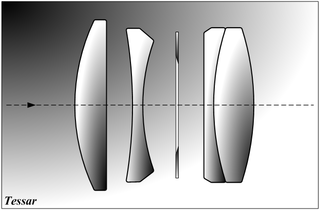
The Tessar is a photographic lens design conceived by the German physicist Dr. Paul Rudolph in 1902 while he worked at the Zeiss optical company and patented by Zeiss in Germany; the lens type is usually known as the ZeissTessar. Since its introduction, millions of Tessar and Tessar-derived lenses have been manufactured by Zeiss and other manufacturers, and are still produced as excellent intermediate aperture lenses.

Konica Minolta, Inc. is a Japanese multinational technology company headquartered in Marunouchi, Chiyoda, Tokyo, with offices in 49 countries worldwide. The company manufactures business and industrial imaging products, including copiers, laser printers, multi-functional peripherals (MFPs) and digital print systems for the production printing market. Konica Minolta's Managed Print Service (MPS) is called Optimised Print Services. The company also makes optical devices, including lenses and LCD film; medical and graphic imaging products, such as X-ray image processing systems, colour proofing systems, and X-ray film; photometers, 3-D digitizers, and other sensing products; and textile printers. It once had camera and photo operations inherited from Konica and Minolta but they were sold in 2006 to Sony, with Sony's Alpha series being the successor SLR division brand.

Minolta Co., Ltd. was a Japanese manufacturer of cameras, camera accessories, photocopiers, fax machines, and laser printers. Minolta Co., Ltd., which is also known simply as Minolta, was founded in Osaka, Japan, in 1928 as Nichi-Doku Shashinki Shōten. It made the first integrated autofocus 35 mm SLR camera system. In 1931, the company adopted its final name, an acronym for "Mechanism, Instruments, Optics, and Lenses by Tashima".

A digital single-lens reflex camera is a digital camera that combines the optics and mechanisms of a single-lens reflex camera with a solid-state image sensor and digitally records the images from the sensor.

Contax began as a German camera model in the Zeiss Ikon line in 1932, and later became a brand name. The early cameras were among the finest in the world, typically featuring high quality Zeiss interchangeable lenses. The final products under the Contax name were a line of 35 mm, medium format, and digital cameras engineered and manufactured by Japanese multinational Kyocera, and featuring modern Zeiss optics. In 2005, Kyocera announced that it would no longer produce Contax cameras. The rights to the brand are currently part of Carl Zeiss AG, but no Contax cameras are currently in production, and the brand is considered dormant.
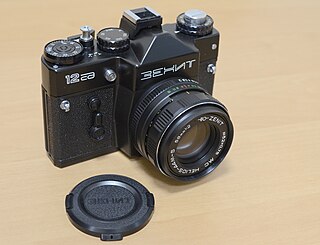
Zenit (Russian: Зени́т) is a Soviet camera brand manufactured by KMZ in the town of Krasnogorsk near Moscow since 1952 and by BelOMO in Belarus since the 1970s. The Zenit trademark is associated with 35 mm SLR cameras. Among related brands are Zorki (Watchful) for 35 mm rangefinder cameras, Moskva (Moscow) and Iskra (Spark) for medium-format folding cameras and Horizon for panoramic cameras. In the 1960s and 1970s, they were exported by Mashpriborintorg to 74 countries.

Advanced Photo System type-C (APS-C) is an image sensor format approximately equivalent in size to the Advanced Photo System film negative in its C ("Classic") format, of 25.1×16.7 mm, an aspect ratio of 3:2 and Ø 30.15 mm field diameter. It is therefore also equivalent in size to the Super 35 motion picture film format, which has the dimensions of 24.89 mm × 18.66 mm and Ø 31.11 mm field diameter.
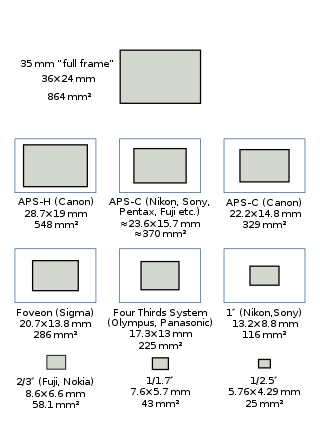
A full-frame DSLR is a digital single-lens reflex camera (DSLR) with a 35 mm image sensor format. Historically, 35 mm was one of the standard film formats, alongside larger ones, such as medium format and large format. The full-frame DSLR is in contrast to full-frame mirrorless interchangeable-lens cameras, and DSLR and mirrorless cameras with smaller sensors, much smaller than a full 35 mm frame. Many digital cameras, both compact and SLR models, use a smaller-than-35 mm frame as it is easier and cheaper to manufacture imaging sensors at a smaller size. Historically, the earliest digital SLR models, such as the Nikon NASA F4 or Kodak DCS 100, also used a smaller sensor.
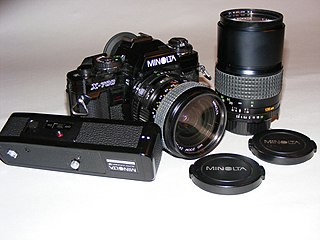
The Minolta X-700 is a 35 mm single-lens reflex film camera introduced by Minolta in 1981. It was the top model of their final manual-focus SLR series before the introduction of the auto-focus Minolta Maxxum 7000.

Sony α is a brand of digital camera. This line has been active since 2006, building upon the Konica Minolta camera technologies, whose assets were acquired by Sony.

The Contaflex series is a family of 35mm Single-lens reflex cameras (SLR) equipped with a leaf shutter, produced by Zeiss Ikon in the 1950s and 1960s. The name was first used by Zeiss Ikon in 1935 for a 35mm Twin-lens reflex camera, the Contaflex TLR; for the earlier TLR, the -flex suffix referred to the integral reflex mirror for the viewfinder. The first SLR models, the Contaflex I and II have fixed lenses, while the later models have interchangeable lenses; eventually the Contaflexes became a camera system with a wide variety of accessories.

The Minolta X-1 was the professional model in the Minolta SR-mount line of single-lens reflex cameras (SLR), released in 1972 after ten years of development, which was the first X-series camera in the Minolta SLR system; prior to the X-1, specific Minolta SLR models were branded SR-T, and afterward, they included X in the name. The X-1 was the first SLR to combine an electronically-controlled shutter with interchangeable viewfinders.
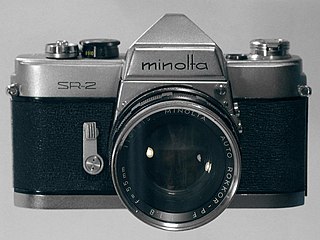
The Minolta SR-2 was presented in 1958 as the first 35mm SLR camera from Chiyoda Kogaku. Popular cameras of this type at that time were mainly from Europe but a few from Japan, including the Asahi Pentax, the Miranda T and the Topcon R. The miniature SLR camera concept was conceived in the 1930s at Ihagee in Dresden, resulting in the 1936 Kine Exakta. Influential cameras designs like that of the 1939 KW Praktiflex, the 1949 ZI Contax S, and 1952 the KW Praktina marked the steady progress toward a perfected SLR. Several features of the latter seem to have influenced the design of the SR-2 although dissimilar in many respects. The obvious similarities are the stepped top plate, the carrying strap lugs, the self-timer lever and some general body features.
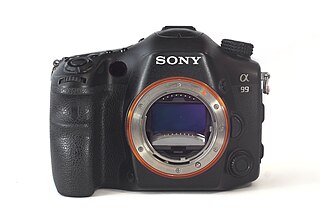
The Sony Alpha 99 was announced by Sony on September 12, 2012. It was the flagship Sony DSLR camera and of the Sony Alpha SLT line until late 2016 when it was replaced by the Sony α99 II.

The Leicaflex series of high-end single-lens reflex 35 mm format film cameras were introduced by Leitz Camera in 1964. The first camera body was paired with the new R bayonet series of lenses. Three model of the cameras were sold by Leitz; the Leicaflex Standard, the Leicaflex SL and the Leicaflex SL2.





















